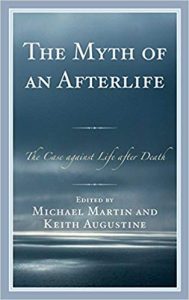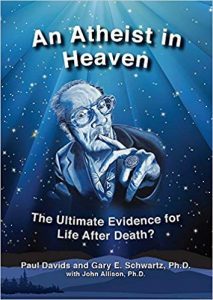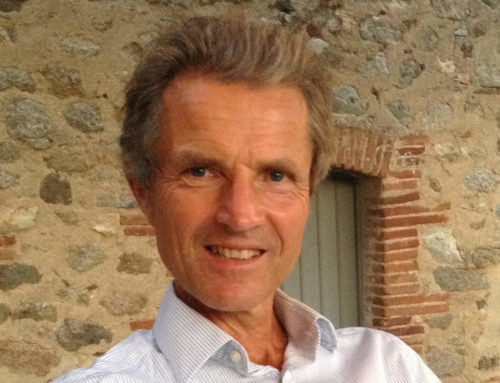Book review by David Lorimer
AFTER LIVES
John Casey
Oxford, 2015, 468 pp.
ISBN: 978-0-19-997503-7
THE MYTH OF THE AFTERLIFE
Edited by Michael Martin and Keith Augustine
Rowman and Littlefield, 2015, 675 pp.
ISBN: 978-0-8108-8677-3
AN ATHEIST IN HEAVEN

Paul Davids and Gary E. Schwartz with John Allison
Yellow Hat Publishing, 2016, 469 pp.
ISBN: 978-0-9890242-4-2
The Life after Death Project – 2 DVDs, 207 mins – www.lifeafterdeathproject.com
 It is unlikely that there will be agreement about the nature of life in relation to a possible afterlife any time soon, as views on this subject depend largely on cultural assumptions and educational background. Faith traditions have their own stories, while modern science eschews both religious and parapsychological sources for different reasons. It is, however, possible, in my view, to draw certain inferences from an evidence base, although again there will be disagreement about exactly what can or cannot be inferred. My own contribution to this debate is summarised in my 1984 book Survival – Body, Mind and Death in the Light of Psychic Experience. People will tend to approach any evidence in two ways: sceptics will tend to use the analogy of the leaky bucket, insisting that there is no perfect case and that all are flawed, while those open to the possibility of valid evidence will tend to use the bundle of sticks analogy, arguing that, while each individual case may not be perfect, there is a cumulative evidential effect. My own predilection is for the latter approach.
It is unlikely that there will be agreement about the nature of life in relation to a possible afterlife any time soon, as views on this subject depend largely on cultural assumptions and educational background. Faith traditions have their own stories, while modern science eschews both religious and parapsychological sources for different reasons. It is, however, possible, in my view, to draw certain inferences from an evidence base, although again there will be disagreement about exactly what can or cannot be inferred. My own contribution to this debate is summarised in my 1984 book Survival – Body, Mind and Death in the Light of Psychic Experience. People will tend to approach any evidence in two ways: sceptics will tend to use the analogy of the leaky bucket, insisting that there is no perfect case and that all are flawed, while those open to the possibility of valid evidence will tend to use the bundle of sticks analogy, arguing that, while each individual case may not be perfect, there is a cumulative evidential effect. My own predilection is for the latter approach.
These three books are very different: the first is a historical and conceptual exploration of the notions of heaven, hell and purgatory; the second makes the case against the afterlife, as the title suggests; while the third is presented as the ultimate evidence for life after death, which no single book can really claim.
John Casey gives a magisterial overview of the Western eschatological tradition – death, judgement, heaven and hell – providing sympathetic and lucid summaries of a vast range of different and at times conflicting sources that is a real pleasure to read. Dark Futures describes the history of hell in Egypt, Mesopotamia and Israel, Greece and Rome, Christian beginnings, Dante, predestination from Augustine to Calvin and beyond, and finally the decline of hell. Then there is a short chapter on Purgatory before the third part exploring the history of conceptions of heaven, again beginning with Egypt, but also discussing the nature of any putative spiritual body, travelling through Dante to Renaissance and Reformation heavens and with, surprisingly, a really excellent chapter on Swedenborg.
Any French mediaeval cathedral conveys the powerful message of judgement, heaven and hell, usually on a graphic portal. Theologically, this is a story of sin and redemption, choice and responsibility. The human being is considered as essentially flawed if not depraved, and opinions vary on how we can best be saved. Augustine, Jansen and the Protestants put a huge emphasis on grace, while Pelagius argues the case for human responsibility and the priority of works over grace and faith. Afterlife prospects in early European thought are uninviting, and it is only with the development of the divinity of the soul in Greek thought that things begin to look up. However, this then gives rise to a dualistic view that has plagued philosophy, leading to the modern scientific denial of the soul and its insistence on the fundamental role of brain activity in generating consciousness, as maintained in the second book.
The reader will find many more obscure thinkers covered in the evolution of these ideas, for instance Samuel Richardson’s 1660 attack on hell, and the free thinking of Thomas Burnet (1637-1715) arguing against eternal punishment. The trend has been towards a greater universalism of salvation. Casey considers Purgatory as perhaps Rome’s happiest inspiration as a halfway house, but it is also true that it gave rise to a huge amount of corruption in the sale of indulgences, reinforcing the power of the Church. However, it also provides an important role for the communion of saints and the idea that the dead are in a sense still with us as well as reinforcing a psychology of repentance.
The section on heaven is equally erudite so that readers come away with a sound understanding of the various doctrines promulgated. This includes the main Protestant thinkers, but also the response from St Francis de Sales and the work of the 17th-century Richard Baxter. One of the first people to deny the immortality of the soul and espouse ‘mortalism’ was Richard Overton in 1675. Isaac Watts has his own heavenly vision, as does Thomas Burnet already mentioned above. On the sceptical side, Casey could have mentioned the influential essay by David Hume.
Next we come to Swedenborg, with what Casey describes as his ‘detailed effrontery’. Having said this, his treatment is very sympathetic, and he recognises Swedenborg as ‘a frank, genial man, curiously matter-of-fact in his accounts of the wonders he has experienced’ (this was also my own initial impression), which argues in favour of his being a visionary rather than a charlatan. What originally struck me were the parallels between Swedenborg and more modern spiritualistic sources, which Casey also covers. For Swedenborg, his was an evidence-based approach, drawing on his own wider perception. Casey could also have mentioned Swedenborg’s reports of conversations with the Protestant reformers and his criticism of vicarious atonement and predestination discussed elsewhere. Swedenborg was also one of the first people to comment on the problems arising from people not realising they have died. Casey discusses Swedenborg’s ideas on conjugal love and marriage in the spiritual world as a representation of the heavenly state.
His treatment of spiritualism and the origins of the Society for Psychical Research is balanced and fair, with an exploration of the impact of the First World War, particularly on Sir Oliver Lodge; however, he could also have mentioned the role of Alfred Russel Wallace. The final chapter reflects that there were a few new ideas about the next life developed in the 20th century, although he could have considered the impact of near death experiences on our ideas last 40 years and the influence of Tibetan Buddhism. Instead, he focuses on theological demythologisation. A consequence of this and secularisation is the loss of a dimension of cosmic moral order relating metaphysics with ethics – and Casey may well be right in concluding that our image of heaven and hell is finally an image of how we judge ourselves.
The Myth of the Afterlife is a massive tome explicitly making the case against life after death with 30 chapters in four parts: empirical arguments for annihilation, conceptual and empirical difficulties for survival, problematic models of the afterlife, and dubious evidence for survival. The use of the word ‘dubious’ in relation to the final part is clearly tendentious in presupposing the best evidence is only dubious. So the reader enters the book with a clear idea of what to expect in terms of an exposition of extinction instead of survival, and mind – brain dependence rather than independence thesis – what we call the mind or soul is in fact entirely biologically based in the body and brain. The editors see their volume as a vital counterbalance to the vast numbers of books by survival proponents ‘that are untempered by adequate consideration of contrary evidence’ – the same could be said in reverse for this volume, although the editors have a very thorough grasp of the philosophical terminology as reflected in the introduction by Keith Augustine. His position is that ‘the survival evidence that we actually have does not even rise to the level of requiring us to postulate either survival or superpsi to explain it’ – an assertion with which I fundamentally disagree but which he makes on the basis that many psychical researchers are too eager to dismiss conventional – i.e. materialistic – explanations; and e is wrong in stating that mediums never reveal specific information unknown to living persons.
Having said this, the volume does provide readers with a sophisticated analysis of many arguments related to survival. Naturally, it raises the question about causation and correlation, but writers tend to take the view that correlations are sufficiently strong so as to amount to causation. They are naturally critical of the filter hypothesis advanced by William James and others, claiming that it is unfalsifiable and remarking that no one understands its mechanism; however, the same is true of the hard problem formulation – we don’t understand how the brain produces consciousness, if indeed it does.
The second part is more philosophical, but again some of the titles of the essays indicate the strong positions of their authors: that survival is metaphysically impossible, that a disembodied afterlife is inconceivable (there may be bodies other than physical), that nonphysical souls violate physical laws and causal closure (causal closure is itself a philosophical assumption), that astral bodies and worlds are implausible, and that our senses revealed the final truth. There are indeed problematic models of the afterlife, as discussed in Part Three, but it is the fourth part that will be most controversial for many readers of this Review. NDEs are classified as hallucinations and while the critiques of Ian Stevenson’s work raises important questions, many of these were discussed by Stevenson himself, including possible errors and the difficulty of finding a totally watertight case – again one is back to the leaky bucket and the bundle of sticks. Given the thoroughness with which Stevenson worked, I found the dismissive framing and conclusion pretty insulting: (it) ‘is full of serious errors, flaws, gaps, messes and difficulties. It does not correspond to the sort of work required in courses on research methods given to third or fourth year college students.’ In this case, the selective engagement in eight pages fails to address the weight and specificity of the case evidence amounting to some 2,400.
A scathing critique of the work of Gary Schwartz provides a good transition into the third book. He is accused of designing an experiment that would guarantee a positive result and conducting his experiments under lax conditions while ignoring or downplaying valid criticisms: ‘the experiment was not scientific and its findings were bogus.’ (p. 612) Gary frames his response to these accusations in a broad framework. The atheist in heaven of the title refers to a series of events after the death of Science Fiction luminary Forrest J Ackerman, who had been a lifelong sceptic and atheist. The book and film describe four types of phenomena: physical, synchronistic, information through mediums and communication through computers. The appendix details over 140 of these events, many of which are striking and inexplicable without postulating the survival in some form of Ackerman.
They begin with the appearance of an inexplicable inkblot, which is then forensically analysed, but include weird phenomena associated with computer screens, papers falling down, objects moving and, most extraordinarily, an anomalous insertion into a proofread article in a magazine of the sentence referring to the inkblot – a sentence that then appears again on the following page. Synchronicities occurred to all those working on the case and different mediums produced, blind, significant factual information about Ackerman and his personality. Whether this represents the ultimate evidence for life after death is up to the reader to decide, but the material is striking enough and cannot in toto be dismissed in terms of chance. In addition, the filmmaker Paul Davids was initially as sceptical as Ackerman himself. The DVDs bring a human immediacy to the extensive and sometimes less digestible material in the book.
Gary presents a scrupulous approach to parapsychological phenomena based on five criteria: reason and theory, scientific evidence, a community of credible believers, direct personal experience, and responsible sceptical re-evaluation of the first four criteria. He discusses the filter theory and its logic in some detail, showing how correlation, stimulation and removal tests do not justify the assumption that the TV set created the image. He analyses various types of research that support the idea of consciousness beyond death and how this has impacted on his own originally atheistic position. As readers will be aware, many distinguished scientists have supported the idea on the basis of evidence as well as personal experience, which Gary has a great deal. This includes an interesting experimental setup on a computer with a programme enabled to register measurements of light. To this, he adds his experience of the current project and analysis of the important distinction between Type I and Type II scepticism. Type I represents the genuinely open-minded position, while representatives of Type II are responsible for the manipulation of Wikipedia entries on parapsychology, including apparently damning indictments of Gary’s work. Overall, the book is a valuable addition to survival research literature.
In conclusion, I am reminded of an essay on survival by the philosopher CD Broad, where he concludes that he will have to wait and see if his consciousness survives death or, alternatively, wait and not see.
Buy After Lives here.
Buy The Myth of the Afterlife here.
Buy An Atheist in Heaven here.

